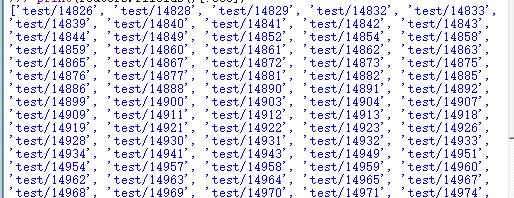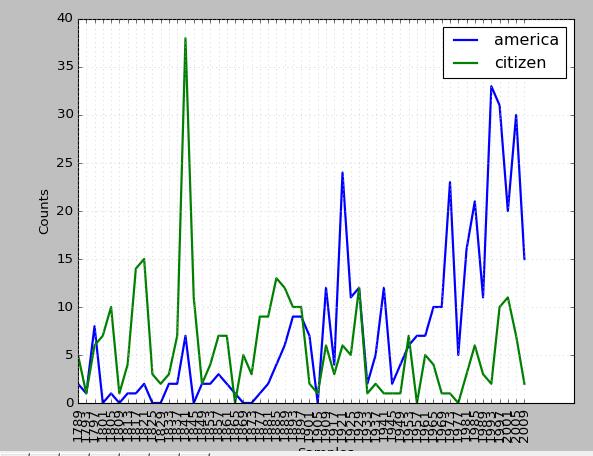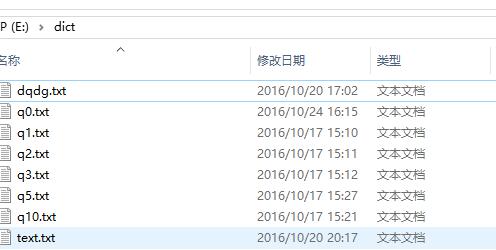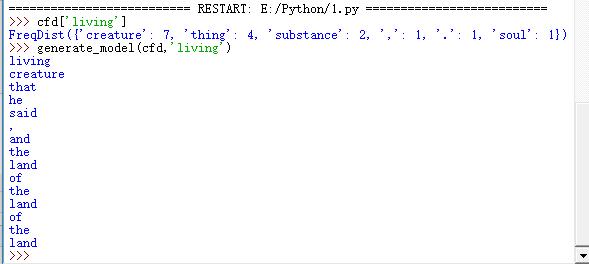Python NLTK 获取文本语料和词汇资源
作者:白宁超
2016年11月7日13:15:24
摘要:NLTK是由宾夕法尼亚大学计算机和信息科学使用python语言实现的一种自然语言工具包,其收集的大量公开数据集、模型上提供了全面、易用的接口,涵盖了分词、词性标注(Part-Of-Speech tag, POS-tag)、命名实体识别(Named Entity Recognition, NER)、句法分析(Syntactic Parse)等各项 NLP 领域的功能。本文主要介绍NLTK(Natural language Toolkit)的几种语料库,以及内置模块下函数的基本操作,诸如双连词、停用词、词频统计、构造自己的语料库等等,这些都是非常实用的。主要还是基础知识,关于python方面知识,可以参看本人的【Python五篇慢慢弹】系列文章(本文原创编著,转载注明出处:Python NLTK获取文本语料和词汇资源)
目录
【Python NLP】干货!详述Python NLTK下如何使用stanford NLP工具包(1)
【Python NLP】Python 自然语言处理工具小结(2)
【Python NLP】Python NLTK 走进大秦帝国(3)
【Python NLP】Python NLTK获取文本语料和词汇资源(4)
【Python NLP】Python NLTK处理原始文本(5)
1 古腾堡语料库
直接获取语料库的所有文本:nltk.corpus.gutenberg.fileids()
>>> import nltk >>> nltk.corpus.gutenberg.fileids()
运行结果:

导入包获取语料库的所有文本
>>> from nltk.corpus import gutenberg >>> gutenberg.fileids() ['austen-emma.txt', 'austen-persuasion.txt', 'austen-sense.txt', 'bible-kjv.txt', 'blake-poems.txt', 'bryant-stories.txt', 'burgess-busterbrown.txt', 'carroll-alice.txt', 'chesterton-ball.txt', 'chesterton-brown.txt', 'chesterton-thursday.txt', 'edgeworth-parents.txt', 'melville-moby_dick.txt', 'milton-paradise.txt', 'shakespeare-caesar.txt', 'shakespeare-hamlet.txt', 'shakespeare-macbeth.txt', 'whitman-leaves.txt']
查找某个文本
>>> persuasion=nltk.corpus.gutenberg.words("austen-persuasion.txt")
>>> len(persuasion)
98171
>>> persuasion[:200]
['[', 'Persuasion', 'by', 'Jane', 'Austen', '1818', ...]
查找文件标识符
num_char = len(gutenberg.raw(fileid)) # 原始文本的长度,包括空格、符号等
num_words = len(gutenberg.words(fileid)) #词的数量
num_sents = len(gutenberg.sents(fileid)) #句子的数量
num_vocab = len(set([w.lower() for w in gutenberg.words(fileid)])) #文本的尺寸
# 打印出平均词长(包括一个空白符号,如下词长是3)、平均句子长度、和文本中每个词出现的平均次数
print(int(num_char/num_words),int(num_words/num_sents),int(num_words/num_vocab),fileid)
运行结果:

2 网络和聊天文本
获取网络聊天文本
>>> from nltk.corpus import webtext >>> for fileid in webtext.fileids(): print(fileid,webtext.raw(fileid))
运行结果

查看网络聊天文本信息
>>> for fileid in webtext.fileids(): print(fileid,len(webtext.words(fileid)),len(webtext.raw(fileid)),len(webtext.sents(fileid)),webtext.encoding(fileid)) firefox.txt 102457 564601 1142 ISO-8859-2 grail.txt 16967 65003 1881 ISO-8859-2 overheard.txt 218413 830118 17936 ISO-8859-2 pirates.txt 22679 95368 1469 ISO-8859-2 singles.txt 4867 21302 316 ISO-8859-2 wine.txt 31350 149772 2984 ISO-8859-2
即时消息聊天会话语料库:
>>> from nltk.corpus import nps_chat
>>> chatroom = nps_chat.posts('10-19-20s_706posts.xml')
>>> chatroom[123]
['i', 'do', "n't", 'want', 'hot', 'pics', 'of', 'a', 'female', ',', 'I', 'can', 'look', 'in', 'a', 'mirror', '.']
3 布朗语料库
查看语料信息:
>>> from nltk.corpus import brown >>> brown.categories() ['adventure', 'belles_lettres', 'editorial', 'fiction', 'government', 'hobbies', 'humor', 'learned', 'lore', 'mystery', 'news', 'religion', 'reviews', 'romance', 'science_fiction']
比较文体中情态动词的用法:
>>> import nltk >>> from nltk.corpus import brown >>> new_texts=brown.words(categories='news') >>> fdist=nltk.FreqDist([w.lower() for w in new_texts]) >>> modals=['can','could','may','might','must','will'] >>> for m in modals: print(m + ':',fdist[m]) can: 94 could: 87 may: 93 might: 38 must: 53 will: 389
NLTK条件概率分布函数:
>>> cfd=nltk.ConditionalFreqDist((genre,word) for genre in brown.categories() for word in brown.words(categories=genre)) >>> genres=['news','religion','hobbies','science_fiction','romance','humor'] >>> modals=['can','could','may','might','must','will'] >>> cfd.tabulate(condition=genres,samples=modals)
运行结果:

4 路透社语料库
包括10788个新闻文档,共计130万字,这些文档分90个主题,安装训练集和测试分组,编号‘test/14826’文档属于测试
>>> from nltk.corpus import reuters >>> print(reuters.fileids()[:500])
运行结果:

查看语料包括的前100个类别:>>> print(reuters.categories()[:100])

查看语料尺寸:
>>> len(reuters.fileids()) 10788
查看语料类别尺寸:
>>> len(reuters.categories()) 90
查看某个编号的语料下类别尺寸:
>>> reuters.categories('training/9865')
['barley', 'corn', 'grain', 'wheat']
查看某几个联合编号下语料的类别尺寸:
>>> reuters.categories(['training/9865','training/9880']) ['barley', 'corn', 'grain', 'money-fx', 'wheat']
查看哪些编号的文件属于指定的类别:
>>> reuters.fileids('barley')
['test/15618', 'test/15649', 'test/15676', 'test/15728', 'test/15871', 'test/15875', 'test/15952', 'test/17767', 'test/17769', 'test/18024', 'test/18263', 'test/18908', 'test/19275', 'test/19668', 'training/10175', 'training/1067', 'training/11208', 'training/11316', 'training/11885', 'training/12428', 'training/13099', 'training/13744', 'training/13795', 'training/13852', 'training/13856', 'training/1652', 'training/1970', 'training/2044', 'training/2171', 'training/2172', 'training/2191', 'training/2217', 'training/2232', 'training/3132', 'training/3324', 'training/395', 'training/4280', 'training/4296', 'training/5', 'training/501', 'training/5467', 'training/5610', 'training/5640', 'training/6626', 'training/7205', 'training/7579', 'training/8213', 'training/8257', 'training/8759', 'training/9865', 'training/9958']
5 就职演说语料库
查看语料信息:
>>> from nltk.corpus import inaugural >>> len(inaugural.fileids()) 56 >>> inaugural.fileids() ['1789-Washington.txt', '1793-Washington.txt', '1797-Adams.txt', '1801-Jefferson.txt', '1805-Jefferson.txt', '1809-Madison.txt', '1813-Madison.txt', '1817-Monroe.txt', '1821-Monroe.txt', '1825-Adams.txt', '1829-Jackson.txt', '1833-Jackson.txt', '1837-VanBuren.txt', '1841-Harrison.txt', '1845-Polk.txt', '1849-Taylor.txt', '1853-Pierce.txt', '1857-Buchanan.txt', '1861-Lincoln.txt', '1865-Lincoln.txt', '1869-Grant.txt', '1873-Grant.txt', '1877-Hayes.txt', '1881-Garfield.txt', '1885-Cleveland.txt', '1889-Harrison.txt', '1893-Cleveland.txt', '1897-McKinley.txt', '1901-McKinley.txt', '1905-Roosevelt.txt', '1909-Taft.txt', '1913-Wilson.txt', '1917-Wilson.txt', '1921-Harding.txt', '1925-Coolidge.txt', '1929-Hoover.txt', '1933-Roosevelt.txt', '1937-Roosevelt.txt', '1941-Roosevelt.txt', '1945-Roosevelt.txt', '1949-Truman.txt', '1953-Eisenhower.txt', '1957-Eisenhower.txt', '1961-Kennedy.txt', '1965-Johnson.txt', '1969-Nixon.txt', '1973-Nixon.txt', '1977-Carter.txt', '1981-Reagan.txt', '1985-Reagan.txt', '1989-Bush.txt', '1993-Clinton.txt', '1997-Clinton.txt', '2001-Bush.txt', '2005-Bush.txt', '2009-Obama.txt']
查看演说语料的年份:
>>> [fileid[:4] for fileid in inaugural.fileids()] ['1789', '1793', '1797', '1801', '1805', '1809', '1813', '1817', '1821', '1825', '1829', '1833', '1837', '1841', '1845', '1849', '1853', '1857', '1861', '1865', '1869', '1873', '1877', '1881', '1885', '1889', '1893', '1897', '1901', '1905', '1909', '1913', '1917', '1921', '1925', '1929', '1933', '1937', '1941', '1945', '1949', '1953', '1957', '1961', '1965', '1969', '1973', '1977', '1981', '1985', '1989', '1993', '1997', '2001', '2005', '2009']
条件概率分布
>>> import nltk >>> cfd=nltk.ConditionalFreqDist((target,fileid[:4]) for fileid in inaugural.fileids() for w in inaugural.words(fileid) for target in ['america','citizen'] if w.lower().startswith(target)) >>> cfd.plot()
运行结果:

标注文本语料库 :许多语料库都包括语言学标注、词性标注、命名实体、句法结构、语义角色等
其他语言语料库 :某些情况下使用语料库之前学习如何在python中处理字符编码
>>> nltk.corpus.cess_esp.words() ['El', 'grupo', 'estatal', 'Electricité_de_France', ...]
文本语料库常见的几种结构:
- 孤立的没有结构的文本集;
- 按文体分类成结构(布朗语料库)
- 分类会重叠的(路透社语料库)
- 语料库可以随时间变化的(就职演说语料库)
查找NLTK语料库函数help(nltk.corpus.reader)
6 载入自己的语料库
构建自己语料库
>>> from nltk.corpus import PlaintextCorpusReader
>>> corpus_root=r'E:dict'
>>> wordlists=PlaintextCorpusReader(corpus_root,'.*')
>>> wordlists.fileids()
['dqdg.txt', 'q0.txt', 'q1.txt', 'q10.txt', 'q2.txt', 'q3.txt', 'q5.txt', 'text.txt']
>>> len(wordlists.words('text.txt')) #如果输入错误或者格式不正确,notepad++转换下编码格式即可
152389
语料库信息:

构建完成自己语料库之后,利用python NLTK内置函数都可以完成对应操作,换言之,其他语料库的方法,在自己语料库中通用,唯一的问题是,部分方法NLTK是针对英文语料的,中文语料不通用(典型的就是分词),解决方法很多,诸如你通过插件等在NLTK工具包内完成对中文的支持。另外也可以在NLTK中利用StandfordNLP工具包完成对自己语料的操作,这部分知识上节讲解过。
7 条件概率分布
条件频率分布是频率分布的集合,每一个频率分布有一个不同的条件,这个条件通常是文本的类别。
条件和事件:
频率分布计算观察到的事件,如文本中出现的词汇。条件频率分布需要给每个事件关联一个条件,所以不是处理一个词序列,而是处理一系列配对序列。
词序列:text=['The','Fulton','County']
配对序列:pairs=[('news','The'),('news','Fulton')]
每队形式:(条件,事件),如果我们按照文体处理整个布朗语料库,将有15个条件(一个文体一个条件)和1161192个事件(一个词一个事件)
按文体计算词汇:
>>> from nltk.corpus import brown >>> cfd=nltk.ConditionalFreqDist((genre,word) for genre in brown.categories() for word in brown.words(categories=genre))
拆开来看,只看两个文体:新闻和言情。对于每个文体,便利文件中的每个词以产生文体与词配对
>>> genre_word=[(genre,word) for genre in ['news','romance'] for word in brown.words(categories=genre)] >>> len(genre_word) 170576
文体_词匹配
>>> genre_word[:4]
[('news', 'The'), ('news', 'Fulton'), ('news', 'County'), ('news', 'Grand')]
>>> genre_word[-4:]
[('romance', 'afraid'), ('romance', 'not'), ('romance', "''"), ('romance', '.')]
条件频率:
>>> cfd=nltk.ConditionalFreqDist(genre_word) >>> cfd <ConditionalFreqDist with 2 conditions> >>> cfd.conditions() ['romance', 'news'] >>> len(cfd['news']) 14394 >>> len(cfd['romance']) 8452
访问条件下的词汇表
>>> from nltk.corpus import brown >>> import nltk >>> cfd=nltk.ConditionalFreqDist((genre,word) for genre in brown.categories() for word in brown.words(categories=genre)) >>> len(list(cfd['romance'])) 8452 >>> len(set(cfd['romance'])) 8452 >>> cfd['news']['The'] 806
绘制分布图和分布表
>>> cfd=nltk.ConditionalFreqDist((target,fileid[:4]) for fileid in inaugural.fileids() for word in inaugural.words(fileid) for target in ['america','citizen'] if word.lower().startswith(target)) >>> cfd.plot(cumulative=True)
运行结果:

生成表格形式展示:
cfd.tabulate(conditions=['English','The'],samples=range(10),cumulative=True)
运行结果:

conditions=['English','The'],限定条件
samples=range(10),指定样本数
8 更多关于python:代码重用
使用双连词生成随机文本: bigrams()函数能接受一个词汇链表,并建立一个连词的词对链表
>>> sent=['Emma', 'Woodhouse', ',', 'handsome', ',', 'clever', ',', 'and', 'rich', ',', 'with', 'a', 'comfortable', 'home', 'and', 'happy', 'disposition', ',', 'seemed', 'to', 'unite', 'some', 'of', 'the', 'best', 'blessings', 'of', ] >>> nltk.bigrams(sent) <generator object bigrams at 0x0103C180>
产生随机文本:定义一个程序获取《创世纪》文本中所有的双连词,然后构造一个条件频率分布来记录哪些词汇最有可能跟在后面,例如living后面可以是creature。定义一个这样的函数如下:Crtl+N,编辑函数脚本
import nltk
def generate_model(cfdist,word,num=15):
for i in range(num):
print(word)
word=cfdist[word].max()
text = nltk.corpus.genesis.words('english-kjv.txt')
bigrams = nltk.bigrams(text)
cfd=nltk.ConditionalFreqDist(bigrams)
F5调用执行函数:
========================== RESTART: E:/Python/1.py ==========================
>>> cfd['living']
FreqDist({'creature': 7, 'thing': 4, 'substance': 2, ',': 1, '.': 1, 'soul': 1})
>>> generate_model(cfd,'living')
运行结果:

Crtl+N打开IDE编辑器,输入以下模块
class MyHello:
def hello():
print("Hello Python")
def bnc():
print("Hello BNC")
def add(num1,num2):
print("The sum is ",str(num1+num2))
Crtl+S保存到本地命名hello.py,并F5运行
============== RESTART: E:/sourceCode/NLPPython/day_03/hello.py ============== >>> from hello import * >>> MyHello.add(1,2) The sum is 3 >>> MyHello.hello() Hello Python
词典资源: 词典或者词典资源是一个词和短语及其相关信息的集合。 词汇列表语料库:
过滤文本:此程序计算文本词汇表,然后删除所有出现在现有词汇列表中出现的元素,只留下罕见的或者拼写错误的词汇 Crtl+N打开IDE编辑器,输入以下模块
class WordsPro:
def unusual_words(text):
text_vocab=set(w.lower() for w in text if w.isalpha())
english_vocab=set(w.lower() for w in nltk.corpus.words.words())
unusual=text_vocab.difference(english_vocab)
return sorted(unusual)
Crtl+S保存到本地命名WordsPro.py,并F5运行
========================== RESTART: E:/Python/1.py ==========================
>>> import nltk
>>> from nltk.corpus import gutenberg
>>> len(WordsPro.unusual_words(nltk.corpus.gutenberg.words('austen-sense.txt')))
1601
>>>
停用词语料库:包括高频词如,the、to和and等。
>>> from nltk.corpus import stopwprds
>>> stopwords.words('english')
定义一个函数来计算文本中不包含停用词列表的词所占的比例,Crtl+N打开IDE编辑器,输入以下模块
def content_faction(text):
stopwords=nltk.corpus.stopwords.words('english')
content = [w for w in text if w.lower() not in stopwords]
return len(content)/len(text)
Crtl+S保存到本地命名WordsPro.py,并F5运行
>>> import nltk >>> from nltk.corpus import reuters >>> WordsPro.content_faction(nltk.corpus.reuters.words()) 0.735240435097661
词迷游戏:3*3的方格出现不同的9个字母,随机选择一个字母并利用这个字母组词,要求如下:
1)词长大于或等于4,且每个字母只能使用一次
2)至少有一个9字母的词
3)能组成21个词为好,32个词很好,42个词非常好
python 程序:
>>> import nltk
>>> puzzle_letters = nltk.FreqDist('egivrvonl')
>>> obligatory = 'r'#默认选择r
>>> wordlist=nltk.corpus.words.words()
>>> [w for w in wordlist if len(w) >=6 and obligatory in w and nltk.FreqDist(w)<=puzzle_letters]
运行结果

词汇工具:Toolbox和Shoebox
Toolbox下载http://www-01.sil.org/computing/toolbox/
9 python 实战:数据文本分词并去除停用词操作:停用词包下载
1 对数据文本进行分词
2 构建自己停用词语料库
3 去除停用词
>>> from nltk.tokenize.stanford_segmenter import StanfordSegmenter
>>> segmenter = StanfordSegmenter(
path_to_jar=r"E: oolsstanfordNLTKjarstanford-segmenter.jar",
path_to_slf4j=r"E: oolsstanfordNLTKjarslf4j-api.jar",
path_to_sihan_corpora_dict=r"E: oolsstanfordNLTKjardata",
path_to_model=r"E: oolsstanfordNLTKjardatapku.gz",
path_to_dict=r"E: oolsstanfordNLTKjardatadict-chris6.ser.gz"
)
>>> with open(r"C:UserscuitbncDesktopdqdg.txt","r+") as f:
str=f.read()
>>> result = segmenter.segment(str)
>>> with open(r"C:UserscuitbncDesktop ext1.txt","w") as wf:
wf.write(result)
1122469
>>> from nltk.corpus import PlaintextCorpusReader
>>> corpus_root=r'E:dictStopWord'
>>> wordlists=PlaintextCorpusReader(corpus_root,'.*')
>>> wordlists.fileids()
['baidu.txt', 'chuangda.txt', 'hagongda.txt', 'zhongwen.txt', '中文停用词库.txt', '四川大学机器智能实验室停用词库.txt']
>>> len(wordlists.words('hagongda.txt'))
977
>>> wordlists.words('hagongda.txt')[:100]
['———', '》),', ')÷(', '1', '-', '”,', ')、', '=(', ':', ...]
>>> stopwords=wordlists.words('hagongda.txt')
>>> content = [w for w in result if w not in stopwords]